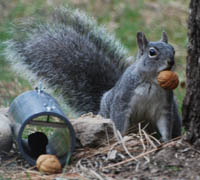Western Gray Squirrel Conservation
The western gray squirrel (Sciurus griseus) is listed as a state-threatened species in Washington State, and as a species of concern by the U.S. Fish and Wildlife Service, and as a sensitive species and management indicator species by the US Forest Service.
Pacific Biodiversity Institute (PBI) started a research and education project in 2009 to study western gray squirrels in the Methow Valley. Read more about PBI's western gray squirrel project here. A report describing our 2010 research results can be downloaded at: Citizen Science Research Report on Western Gray Squirrel Distribution in the Upper Methow Valley, by Asako Yamamuro, Kim Romain-Bondi, and Peter Morrison.
The goal of the western gray squirrel project is to help Washington Dept of Fish and Wildlife (WDFW) gain a better understanding of the extent of western gray squirrel presence in the Methow Valley and to involve the public in conservation efforts to help insure the survival of western gray squirrels. PBI is working in partnership with WDFW, conducting non-invasive hair-tube distribution surveys.
Human land use activities have decreased the amount of habitat and overall habitat conditions for the western gray squirrel. In Washington State, the western gray squirrel is currently known to exist in only three locations; one of which is in Chelan and Okanogan Counties (the North Cascades population). In response, the Washington Department of Fish and Wildlife has undertaken population and occurrence studies and put together a recovery plan (Linders and Stinson 2007) to guide land management activities in squirrel habitat. The current economic downturn has greatly impaired the ability of the Washington Department of Fish and Wildlife to continue studies and monitoring of western gray squirrels in the North Cascades. The informational vacuum left by the inability of WDFW to continue western gray squirrel studies leaves Pacific Biodiversity Institute with a unique opportunity and organizational responsibility to contribute scientific knowledge and analyses on a local population of a threatened species.
In 1993, the Washington State Department of Fish and Wildlife (WDFW) listed the western gray squirrel as a state-threatened species due to an uncertain future for the extant isolated populations and due to reduced habitat ranges. General ecology studies conducted statewide identified a magnitude of potential threats to these small isolated populations of animals. These threats include non-native interspecific competition, habitat loss, road mortality, disease outbreak, genetic inbreeding, and potentially others, but more research is necessary to determine if these affects are consequently limiting the long-term viability of western gray squirrels in the state, and specifically, in the North Cascades population.
Of the three populations in Washington State, the least is known about the North Cascades population. Due to the area’s unrepresentative habitat (lack of oak forests), the population’s remote location, and the technical difficulties of studying a low density population of mammals, large data gaps exist on the distribution, population trends, and ecology of the North Cascades population.
References
Bartels, P. 1995. Western gray squirrel survey in Okanogan and Chelan Counties, Washington. Unpublished report, Washington Department of Fish and Wildlife, Olympia, WA. 4 pp + appendices.
Bartels, P. 2000. Western gray squirrel survey in Okanogan and Chelan Counties, Washington. Unpublished report, Washington Department of Fish and Wildlife, Olympia, WA. 4 pp + appendices.
Chappell, C.B., M.S. Mohn Gee, B. Stephens, R. Crawford, and S.Farone.2001.Distribution and decline of native grassland and oak woodlands in the Puget Lowland and Willamette Valley Ecoregions, Washington. Pp 124 –139 In S.H. Reichard, P.W. Dunwiddie, J.G. Gamon, A.R. Kruckberg, and D.L. Salstrom (eds.) Conservation of Washington ’s Rare Plants and Ecosystems. Washington Native Plant Society, Seattle. 223 pp.
Johnson, R.E. and K.M. Cassidy. 1997. Mammals of Washington state: Location data and predicted distributions. Volume 3 in K.M. Cassidy, C.E. Grue, M.R. Smith, and K.M. Dvornich, eds. Washington State Gap Analysis- Final Report. Washington Cooperative Fish and Wildlife Research Unit, University of Washington, Seattle, WA. 304 pp.
Johnson, D.H. and T. A. O’Neil (eds). 2001. Wildlife-habitat relationships in Oregon and Washington. Oregon State University Press, Corvallis, OR. 736 pp.
Long, Kim. 1995. Squirrels - A Wildlife Handbook. Johnson Nature Series, Johnson Printing. 181 pp.
Steele, Michael, and John Koprowski. 2001. North American Tree Squirrels. Smithsonian Institution. 201pp.
Thorington, Richard Jr. and Katie Ferrell. 2006. Squirrels - The Answer Guide. Johns Hopkins University Press. 183 pp.
Copyright © 2009 Pacific Biodiversity Institute
PO Box 298, 517 Lufkin Lane
Winthrop, WA 98862 509-996-2490
 Marine Mammals
Marine Mammals